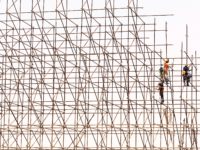Treated wood’s strength is comparable to carbon fiber


Brief:
- University of Maryland College Park engineers have discovered a way to treat wood to make it 12 times stronger and 10 times tougher than non-treated wood, according to a University of Maryland A. James Clark School of Engineering statement.
- The team claims it is comparable to carbon fiber and could be a competitor material to steel, which it is six times lighter than, and titanium alloy.
- The wood, which is treated by removing the wood’s lignin, compressing it then coating it with paint, underwent tests where the team shot a bullet-like projectile at it. That projectile went through natural wood, but the treated wood stopped the projectile partway through.
Insight:
Scientists and engineers worldwide are examining new technologies to replace or enhance traditional building materials. Dutch researchers at the Delft University of Technology created an asphalt composition that resembles closed-loop circuits and is infused with electrically conductive fibers, while Swiss scientists created a method enabling iron oxide nanoparticles in surface cracks to heal surrounding asphalt when exposed to an alternating magnetic field. Both innovations could lead to replacing traditional roadway materials with self-healing asphalt.
Self-healing concrete is also on the horizon. Binghampton University-State University of New York and Rutgers University announced early this year they had developed a self-healing fungi concrete. When a certain fungus is mixed with concrete, it will lie dormant until a crack appears and, as water and oxygen infiltrate, the fungal spores germinate, grow and produce needed calcium carbonate to heal the cracks.
Finding lighter weight materials without compromising strength is another research endeavor. Various manufacturers have formulations to create polystyrene concrete blocks, which generally comprise cement silica aggregate, recycled polystyrene granules and modifying agents. These blocks are lighter than traditional concrete, which reduce labor when constructing masonry walls while increasing the speed at which they’re built.
AeroAggregates LLC uses post-consumer mixed-glass waste and recycling to make foamed glass aggregate, which is similar to crushed rock, but weighs 85% less than stone. Researchers at Drexel University and Lafayette College are determining if it can be used as an aggregate in concrete to create a lighter alternative for nonstructural uses. Five states have given an initial okay to use the product, with the Pennsylvania DOT already using the material under a section of a reconstruction project.
Construction materials might be made from all manners of recycled materials in the future, including organic waste. Engineering firm Arup has suggested building material substitutions, including skyscrapers from mushrooms, bricks from rice and walls from corn and wheat, to name a few.
This article was originally written by Laurie Cowen and appeared here.


Comment (0)